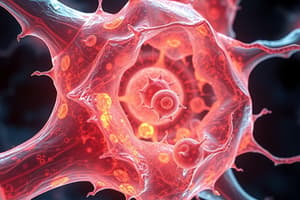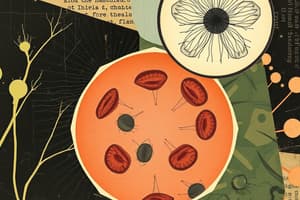Podcast
Questions and Answers
What is the most common childhood cancer?
What is the most common childhood cancer?
- B cell ALL (correct)
- T cell Lymphoma
- Chronic Lymphocytic Leukemia (CLL)
- Acute Myeloid Leukemia (AML)
Fever occurs in 50% of cases of B cell ALL.
Fever occurs in 50% of cases of B cell ALL.
True (A)
What is the primary antigen associated with immature B cells?
What is the primary antigen associated with immature B cells?
CALLA antigen (CD 10⁺)
The classical presentation of T cell ALL includes ______ and pleural effusion.
The classical presentation of T cell ALL includes ______ and pleural effusion.
Match the type of leukemia with its characteristic feature:
Match the type of leukemia with its characteristic feature:
Which of the following is a risk factor for both Acute Myeloid Leukemia and Acute Lymphoblastic Leukemia?
Which of the following is a risk factor for both Acute Myeloid Leukemia and Acute Lymphoblastic Leukemia?
Adults with Acute Lymphoblastic Leukemia typically present with anemia, neutropenia, and thrombocytopenia.
Adults with Acute Lymphoblastic Leukemia typically present with anemia, neutropenia, and thrombocytopenia.
What is a common presenting feature in children with Acute Lymphoblastic Leukemia?
What is a common presenting feature in children with Acute Lymphoblastic Leukemia?
In children with Acute Lymphoblastic Leukemia, a high count of ______ is associated with a very poor prognosis.
In children with Acute Lymphoblastic Leukemia, a high count of ______ is associated with a very poor prognosis.
Match the following laboratory features with their potential implications:
Match the following laboratory features with their potential implications:
What is an indication for Allogenic Hematopoietic Stem Cell Transplantation (AHSCT)?
What is an indication for Allogenic Hematopoietic Stem Cell Transplantation (AHSCT)?
High-dose Cytarabine is mandatory for patients with standard risk and MRD (-).
High-dose Cytarabine is mandatory for patients with standard risk and MRD (-).
What is the prognosis for a patient with Acute Promyelocytic Leukemia (AML M3) when treated?
What is the prognosis for a patient with Acute Promyelocytic Leukemia (AML M3) when treated?
A patient with 0.01% blasts in marrow is considered MRD ______.
A patient with 0.01% blasts in marrow is considered MRD ______.
Match the following drugs with their categories:
Match the following drugs with their categories:
What is a characteristic feature of hypergranular promyelocytes?
What is a characteristic feature of hypergranular promyelocytes?
Acute leukemia can lead to early mortality due to severe hemorrhage.
Acute leukemia can lead to early mortality due to severe hemorrhage.
What treatment should be initiated early if acute myeloid leukemia M3 is suspected?
What treatment should be initiated early if acute myeloid leukemia M3 is suspected?
In patients with high-risk acute leukemia, the WBC count is greater than ______.
In patients with high-risk acute leukemia, the WBC count is greater than ______.
Match the following types of promyelocytes with their characteristics:
Match the following types of promyelocytes with their characteristics:
Which marker is NOT associated with B cells?
Which marker is NOT associated with B cells?
Naive B cells do not express CD 19.
Naive B cells do not express CD 19.
What can failure of apoptosis lead to in lymphoid cells?
What can failure of apoptosis lead to in lymphoid cells?
The preferred marker for identifying precursor B cell ALL is _____ .
The preferred marker for identifying precursor B cell ALL is _____ .
Match the B-cell types with their corresponding prognosis:
Match the B-cell types with their corresponding prognosis:
Which of the following is considered a bad prognostic factor for Acute Leukemia?
Which of the following is considered a bad prognostic factor for Acute Leukemia?
Therapy-associated AML is considered a good prognostic factor for Acute Leukemia.
Therapy-associated AML is considered a good prognostic factor for Acute Leukemia.
What age group is considered a bad prognostic factor in Acute Leukemia?
What age group is considered a bad prognostic factor in Acute Leukemia?
Patients experiencing anemia, leukopenia, or thrombocytopenia for more than one month before diagnosis are considered to have __________ prognostic factors for Acute Leukemia.
Patients experiencing anemia, leukopenia, or thrombocytopenia for more than one month before diagnosis are considered to have __________ prognostic factors for Acute Leukemia.
Match the following treatments or factors with their classification:
Match the following treatments or factors with their classification:
What is the survival rate for children under 10 years old diagnosed with Acute Lymphoblastic Leukemia?
What is the survival rate for children under 10 years old diagnosed with Acute Lymphoblastic Leukemia?
Acute Myeloid Leukemia is characterized by the presence of nucleoli in its cells.
Acute Myeloid Leukemia is characterized by the presence of nucleoli in its cells.
What type of leukocytes primarily affect Acute Lymphoblastic Leukemia?
What type of leukocytes primarily affect Acute Lymphoblastic Leukemia?
Acute Myeloid Leukemia (AML) is associated with the presence of ________, which are absent in Acute Lymphoblastic Leukemia (ALL).
Acute Myeloid Leukemia (AML) is associated with the presence of ________, which are absent in Acute Lymphoblastic Leukemia (ALL).
Match the features with the corresponding type of cell (Lymphoblast/Myeloblast):
Match the features with the corresponding type of cell (Lymphoblast/Myeloblast):
What is the prognosis associated with the t(8; 21) genetic abnormality?
What is the prognosis associated with the t(8; 21) genetic abnormality?
The presence of an NPM mutation is associated with a bad prognosis.
The presence of an NPM mutation is associated with a bad prognosis.
Which CD markers are associated with myeloblasts?
Which CD markers are associated with myeloblasts?
The genetic abnormality t(9; 22) is associated with a ______ prognosis.
The genetic abnormality t(9; 22) is associated with a ______ prognosis.
Match the following genetic abnormalities with their associated characteristics:
Match the following genetic abnormalities with their associated characteristics:
Which of the following factors is associated with a bad prognosis in Acute Lymphoblastic Leukemia?
Which of the following factors is associated with a bad prognosis in Acute Lymphoblastic Leukemia?
Transplantation is recommended only after a positive result in the bone marrow study for ALL.
Transplantation is recommended only after a positive result in the bone marrow study for ALL.
What is the goal of the induction phase in the treatment of Acute Lymphoblastic Leukemia?
What is the goal of the induction phase in the treatment of Acute Lymphoblastic Leukemia?
In the treatment regimen for Acute Lymphoblastic Leukemia, __________ is used to reduce CNS relapses.
In the treatment regimen for Acute Lymphoblastic Leukemia, __________ is used to reduce CNS relapses.
Match the following features with their corresponding prognosis type in Acute Lymphoblastic Leukemia:
Match the following features with their corresponding prognosis type in Acute Lymphoblastic Leukemia:
Which of the following skin involvement characteristics is true for leukemia cutis?
Which of the following skin involvement characteristics is true for leukemia cutis?
Myeloblasts are characterized by the presence of prominent nucleoli.
Myeloblasts are characterized by the presence of prominent nucleoli.
What type of anemia is commonly seen in patients with acute leukemia?
What type of anemia is commonly seen in patients with acute leukemia?
In acute leukemia, the total WBC count is typically less than ______ cells.
In acute leukemia, the total WBC count is typically less than ______ cells.
Match the following features with their corresponding type of cell:
Match the following features with their corresponding type of cell:
Flashcards are hidden until you start studying
Study Notes
B Cell Types
- Pro B cell: Incomplete rearrangement of heavy chain
- Pre B cell: Complete rearrangement of heavy chain, CD 10⁺ (CALLA antigen), good prognosis
- Immature B cell: Complete rearrangement of heavy and light chain, loses CD 10, bad prognosis
Acute Lymphocytic Leukemia (ALL)
- Most common childhood cancer
- Features of bone marrow failure: fever, cytokine production by lymphoblasts, marrow cavity expansion, bleeding tendencies, CNS involvement
- B cell ALL: Most common subtype in childhood
- T cell ALL: Often presents with mediastinal mass and pleural effusion
- CNS involvement is common in both types
Acute Myeloid Leukemia (AML)
- No fever
- HTLV-1: Organism that produces adult T cell lymphoma
- AML M3: Presents with bleeding and pancytopenia, has good prognosis with treatment
- Granules in promyelocytes activate the extrinsic cascade, leading to DIC and hemorrhage
- Prognosis is influenced by age, leukocyte count, anemia, thrombocytopenia, and genetic factors
- Treatment includes induction, consolidation, and maintenance phases
- Drugs: hypomethylating agents (azacitidine, decitabine), Venetoclax, Gemtuzumab-Ozogamicin, Ivosidenib
Risk Factors:
- Down syndrome
- Malignancy: Transient abnormal myelopoiesis
- Defective DNA repair: Ataxia-telangiectasia, Bloom's syndrome
- Radiation
Presenting Features
- Adults: Pancytopenia
- Children: Limping, bone tenderness, inability to walk, dyspnea, mediastinal widening
- T cell ALL in adolescents: High count ALL = poor prognosis, involves sanctuary sites (CNS, testes)
- Relapse after treatment: Requires intrathecal chemotherapy
- Rare symptoms: Pallor, petechiae, ecchymosis, fatigue, lethargy, organomegaly
Laboratory Features
- In blood: Anemia, neutropenia, thrombocytopenia, circulating blasts, variable counts, hypereosinophilia preceding blasts
- In CSF: Leukemic blasts
Evaluation After Induction Phase
- 5% blasts in marrow: Refractory AML, inevitable death
- MRD: Predicts risk of relapse (0.01% blasts = bad prognosis)
Consolidation Phase
- Allogenic Hematopoietic Stem Cell Transplantation (AHSCT): Indicated for patients with MRD (-)
- High-dose Cytarabine: Indicated in standard risk with MRD (-), transplant not mandatory
Lymphoma
Diagram
- Common lymphoid progenitor gives rise to B cells, T cells, and NK cells
- CD 19: B cell marker, CD 3: T cell marker, CD 56: NK cell marker
B Cell Lymphoma
- Pro B cell: Incomplete rearrangement of heavy chain, bad prognosis
- Pre B cell: Complete rearrangement of heavy chain, good prognosis, loses CD 34 and HLA-DR
- Immature B cell: Complete rearrangement of heavy and light chain, loses CD 10, bad prognosis
- Naive B cell: No antigen encounter
- Precursor B cell ALL:
Pathophysiology (ALL & Myeloblast)
- ALL: Better prognosis in children, affects bone marrow, can involve thymus (mediastinal widening and dyspnea)
- Myeloblast: Poor prognosis, affects bone marrow, can involve thymus (mediastinal widening and dyspnea)
Lymphoblast vs Myeloblast
- Lymphoblast: Smaller, absent nucleoli, absent granules
- Myeloblast: Larger, present nucleoli, present granules
Prognostic Factors (ALL)
- Good prognosis: White race, 2-9 years, female, no CNS involvement, no hepatosplenomegaly/lymphadenopathy/mediastinal mass, LI type, hyperdiploidy (t(12;21)), NPM mutation without FLT3-ITD, CEBPA mutation
- Bad prognosis: Black race, >10 years, male, CNS involvement, hepatosplenomegaly/lymphadenopathy/mediastinal mass, L2/L3 type, hypodiploidy (t(9;22), t(4; 11), t(1;19)), FLT3-ITD mutation
Treatment of ALL
- Induction Phase (2 cycles): Goal is remission, BFM-19 protocol (steroids, vincristine, daunorubicin, cyclophosphamide), bone marrow study for MRD status
- Negative MRD: Consolidation phase (2 more cycles of chemotherapy)
- Positive MRD: 2 cycles of chemotherapy, then transplant
- Maintenance Phase: Methotrexate + 6-mercaptopurine for 2-3 years
- Other Drugs: Rituximab (CD20+ve), intrathecal methotrexate, blinatumomab (bispecific T-cell engager), tyrosine kinase inhibitors (BCR-ABL+ve)
Cytology
- MPO and Sudan black +: M4, M5, M7
- NSE, PAS +: M6, M7
Immunophenotyping
- Myeloblast: CDIIb, CD13, CD33, CD117, HLA-DR
- Promyelocyte: CD13, CD33
- Myelomonoblast: CDIIb, CD13, CD33, CD14, HLA-DR
- Monoblast: CDIIb, CD13, CD33, CDIIC, HLA-DR
- Erythroid leukemia: Glycophorin, spectrin
- Megakaryocytic (M7): CD41, CD61
Cytogenetics & Molecular Genetics
- Recurrent genetic abnormalities:
- t(8; 21): Most common, RUNX1-RUNXT translocation, good prognosis
- t(16; 16): Abnormal eosinophils, myelomonocytic leukemia, good prognosis
- t(9; 22): Bad prognosis (except in CML)
- Mutations:
- c-kit mutation: Bad prognosis
- NPM (Nucleophosmin-1) mutation: Cup-shape blasts, good prognosis, most common
- CEBPA mutation: Good prognosis
Prognosis (European Risk Stratification)
- Favourable: t(8; 21), t(16; 16), NPM mutation without FLT3-ITD, CEBPA mutation
- Intermediate: No cytogenetic abnormalities
- Unfavourable: All other mutations
Skin Involvement
- Leukemia cutis: Non-tender, violaceous nodular skin lesions
- Sweet syndrome: Tender, erythematous, violaceous papules/plaques (Neutrophilic infiltration of dermis), site is face and neck
- Causes: AML (monoblastic lineage), G-CSF therapy, PMF
- Treatment: Chemotherapy, steroids
Evaluation (Skin Involvement)
- Blood picture: Normocytic normochromic anemia, low platelets (<1 lac cells), low WBC count (<4000 cells)
Morphology (Myeloblast & Promyelocyte)
- Myeloblast: Large, uniform blast cell with high nuclear:cytoplasm ratio, pale blue scanty cytoplasm and granules, 1-4 prominent nucleoli, Auer rods present (more prominent in AML M3), fine dispersed chromatin
- Promyelocyte: Larger cell, more visible granules, absence of nucleoli, clustering of Auer rods (faggot cells), AML M3 (promyelocytic leukemia)
Studying That Suits You
Use AI to generate personalized quizzes and flashcards to suit your learning preferences.




